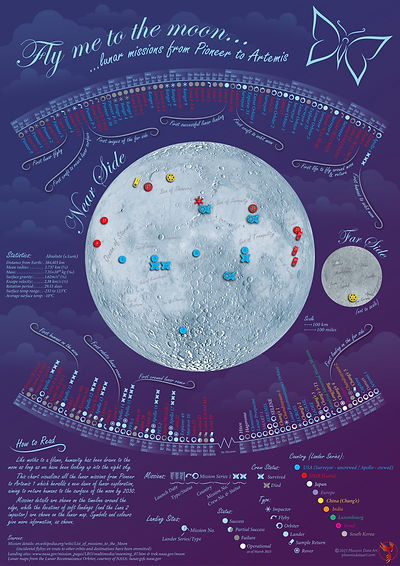
Fly me to
the Moon...
...lunar missions from Pioneer to Artemis
Supporting the International Astronomical Union
Like moths to a flame, humanity has been drawn to the moon as long as we have been looking up into the night sky.
This digital artwork visualises all the lunar missions from Pioneer to Artemis 1, which heralds a new dawn of lunar exploration, intending to return humans to the lunar surface by 2030.
Scroll down to learn more about Fly me to the Moon..., the data visualisation artwork, and the charity it supports.
How to Read
Mission details are shown on the timeline around the edge, while the locations of soft landings (and the Luna 2 impactor) are shown on the lunar map.
Symbols and colours give more information, as shown:

About Fly me to the Moon...
On November 16, 2022, at 06:47:44 UTC, Artemis 1 was successfully launched. The first of the Artemis missions, this marks Nasa's return to lunar exploration after the conclusion of the Apollo program, decades earlier.
The Artemis program heralds a new dawn of lunar exploration, intending to return humans to the lunar surface by the end of this decade. The main objective of Artemis 1 was as an uncrewed test of the new Space Launch System and Orion spacecraft in preparation for subsequent Artemis missions. These lunar missions will also be used as a test-bed for technologies which will be needed to enable future crewed exploration of Mars.
This digital art work celebrates the success of Artemis 1 and the return of humanity to the moon, and visualises all the lunar missions from Pioneer, in 1958, up to and including Artemis 1 in 2022.
Image: Artemis I Infographic
Credit: NASA image/Kevin O’Brien


About the Data
The data used in this visualisation has primarily been drawn from the Wikipedia page about lunar missions. Data on missions which flew past the moon for gravity assist en-route to other orbits or destinations has been removed for clarity.
This has been supplemented by additional data on the lunar landing sites from NASA and from Moon Trek.
Maps of the lunar surface are from the Lunar Reconnaissance Orbiter, courtesy of NASA.
Image: Lunar Landing Sites
Credit: NASA




Inspiration
Inspiration for the colours and shapes used in this visualisation has been drawn from moonlight and moths, the NASA Artemis I infographic shown above, and numerous fantasy art works incorporating the moon or lunar elements, such as these pieces by fantasy artist Anne Stokes.
You can see more of Anne's work and buy these pieces from the Anne Stokes website.
Images: Mystic Aura, Immortal Flight, Moonstone, Moon Witch
Image credit: Anne Stokes

About the Charity
International Astronomical Union
Prints of this visualisation are being sold to raise funds for the International Astronomical Union (IAU).
Astronomy inspires curiosity and wonder, which can foster a lifelong interest in science. The IAU supports astronomy and its contribution to societal change via initiatives such as Telescopes for All, and online astronomy classes for children around the globe.
There is more information about projects supported by the IAU on their website, where you can also make a direct donation to the IAU.
Costs of production and shipping are deducted, but all profits go to the IAU.



